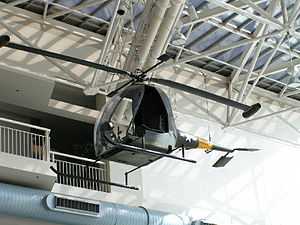Tip jet

Tip jet refers to the jet nozzles at the tip of some helicopter rotor blades, to spin the rotor, much like a Catherine wheel firework.
Some tip jets use compressed air, provided by a separate engine, to create jet thrust. Others use an afterburner type system to burn fuel in the compressed air at the tip (tip-burners) to enhance the thrust. Some are ramjets or even a complete turbojet engine. Some are rocket tip jets that run off stored propellant such as hydrogen peroxide.
Tip jets replace the normal shaft drive and have the advantage of placing no torque on the airframe, so no tail rotor is required.
Some simple monocopters are composed of nothing but a single blade with a tip rocket.[1][2]
The Italian designer V Isaaco built "Helicogyre"s in the 1920s which used piston engines at the ends of the rotary wing and he foresaw that they might be replaceable by jets.[3]
During the Second World War a German, Friedrich von Doblhoff, suggested powering a helicopter with ram jets. The first tip jet-powered helicopter was the WNF 342 V1 in 1943. After the war two WNF 342 prototypes ended up with the Americans and Doblhoff joined McDonnell Douglas who subsequently produced the McDonnell XV-1. The engineer who had actually produced the tip jet engines, August Stephan, joined the Fairey Aviation company of the United Kingdom which used them in their Fairey Jet Gyrodyne and Fairey Rotodyne aircraft first flying in 1954 and 1957 respectively.
Eugene Michael Gluhareff was an early pioneer of tip jets.
If the helicopter's engine fails the tip jets on the rotor increases the moment of inertia, hence permitting it to store energy, which makes doing a successful autorotation landing somewhat easier. However, the tip jet also typically generates significant extra air drag, which demands a higher sink rate and means that a very sudden transition to the landing flare must occur for survival, with little room for error.
Rotorcraft using tip jets
- Percival P.74 - used engines in fuselage to produce efflux at wingtips. Engines never produced sufficient power and so it never flew. Further progress with the design using more powerful engines was cancelled.
- Hiller YH-32 Hornet - first flying 1950, 'jet jeep' had good lifting capability but was otherwise poor
- Mil V-7 - Soviet turbojet helicopter
- Fairey Jet Gyrodyne - provided data for the Rotodyne. First flew in 1954.
- Fairey Rotodyne - 48 seater short-haul airliner design. First flew in 1957. Cancelled due to doubts about noise of tipjets in service.
- Fairey Ultra-light Helicopter - First flew in 1955. Four built for military use but defence cuts left Fairey to continue development without support and there were no further orders.
- Fiat 7002 - first flew in 1961, only one built
- Focke-Wulf Fw Triebflügel German World War II interceptor design — not built
- McDonnell XV-1 - flew in 1954, compound gyroplane, cancelled due to insufficient advantage over contemporary helicopters
- Hughes XH-17 - flying crane (largest rotor of any type on a helicopter), cancelled due to inefficient design (range around 40 miles)
- NHI H-3 Kolibrie (Nederlandse Helikopter Industrie ) (ca 11 built)
- Innosuisse SwissCopter (DragonFly)
- Rotary Rocket Roton ATV
- Sud-Ouest Djinn - First flew in 1953. Use compressed air tip jets
- JK-1 Trzmiel (Polish prototype one-seat helicopter)
- VFW-Fokker H3 - two flew[4]
None apart from the Sud-Ouest Djinn have made it into production.
See also
References
- ↑ Peklicz, Joseph, 2001, "Build the Monocopter" Sport Rocketry 44,2 March–April, 2001 p 34
- ↑ Hodge, Jon, 2000, "Monocopter C6 MII Review" Cosrocketeer, 12, 4, July–August, 2000 p. 4-5
- ↑ "The 'Helicogyre'", Flight, 21 March 1929: 244–245
- ↑ Robb, Raymond L. "Hybrid helicopters: Compounding the quest for speed", page 34. Vertiflite. American Helicopter Society, Summer 2006.